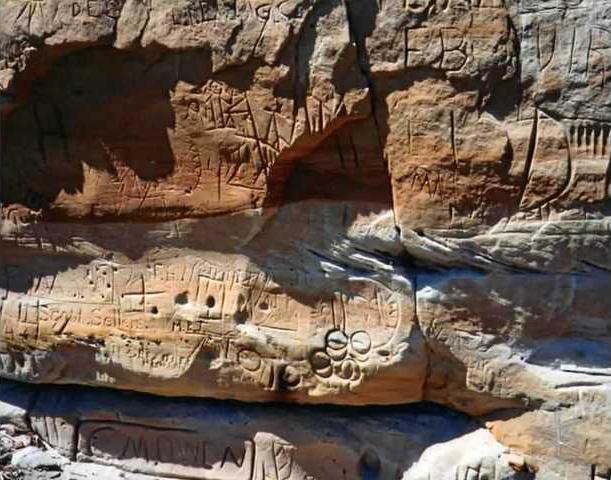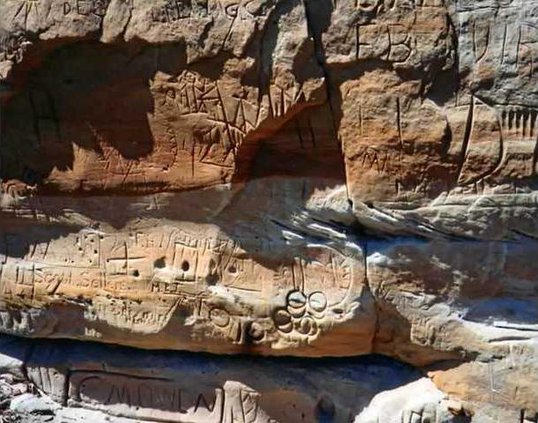LUCAS – Ever since he was a wee lad scrambling among the rocky limestone bluffs around what is now Wilson Lake, D. Craig Lilak has been intrigued with the Native American etchings known as petroglyphs.
“I’ve always been fascinated with them,” he said, recalling trips with his grandfather to what were then cattle pastures. That was in the late 1950s and those expeditions sparked a life-long passion in young Lilak.
The Wilson man’s years of combing the hills and valleys of north central Kansas, and an intense interest in Native American History and art are the inspiration for a program he will present at the March 10 at the Grassroots Arts Center, 213 S. Main. in Lucas. He also has an exhibit photographs and artifacts – “Visions of the Past - Native American Petroglyphs” – at the center.
The public is invited to attend his discussion on this topic. There will be no admission charge for this event.
Lilak has offered a duplicate set of photographs that are in the exhibit for written bid. The proceeds will benefit the art center.
There is one downside to the hobby. “I spend a lot of time out in the boonies,” he said.
But, “it’s just a thrill to find something that no one has seen for 300 or 400 years. He has also found Indian Wars-era military items and chain-male armor from the days of Coronado.
He also spent 10 years in the Marines, traveling around the world. He saw similar drawings in other countries and found parallels to the ones he saw back home.
What are petroglyphs?
The Saline River Valley of central Kansas was the best hunting ground available and the only place to obtain salt for hundred of miles. It had been used by Native Americans for thousands of years before horses were brought to Kansas. The first white settlers used it for the same reasons. In the 20th century it had the best fishing holes, and now it’s a recreational lake for boating, fishing and water sports used by thousands.
According to information from the U.S. Army Corps of Engineers, rock art, known as petroglyphs, remain as the last pictorial evidence of the tribal lifestyles of Native Americans that ventured the wild frontier this region had to offer. The vast amount of Dakota Sandstone boulders and cliffs in this historic region served as an ancestral drawing board to scratch, peck, and chisel their way of life.
Tribes roaming the area included the Pawnee, also known as the Quiviras, the Comanches and the Cheyenne.
Most of these were probably etched into the Dakota sandstone cliffs between 1700 and 1850.
These American Indian sketches have depicted materialistic ornaments, buffalo headdresses and feathers, and weapons of spears and bow and arrow. The petroglyphs show explicit detail to astronomy and god-like figures that influenced the warriors and chiefs to lead their people by defending invading tribes and harvesting wild game like bison, elk, and turkey.
Most petroglyph locations were along wild game trails and water sources near springs. Occasionally their incisions depicted the times of fertility among females and exaggerated depictions of genitals among the males.
The Native Americans of this region made their first contact with Europeans in the 1500s. The Spanish Conquistador’s explorations led by Coronado were depicted by Indian rock art by the introduction of decorated horse and mule into tribal lifestyle.
The timeline of petroglyphs left behind are the only remaining evidence of the romance of the story of nomadic mankind, American Indians, and the European immigrants to come.
Some petroglyphs have stood the test of time, but most have become vandalized beyond recognition, Lilak said. And, the historic petroglyphs are difficult to find at times with all the more current autographs left by people on the same rock.
One petroglyph site at Wilson Lake has “autographs” of notable persons such as William Cody, Wild Bill Hickock, and Frank and Jesse James. These signatures were noted as early as the 1947 report, but current speculation is that they are forgeriesA 1986 study reported that this site is now underwater.
Lilak said now he just photographs the carvings and doesn’t reveal where they are.
There is a lot of history out there, he said. “People don’t have a clue what happened in this area.”
For more information, call the art center at 785-525-6118.
PICTURES FROM THE PAST
Petroglyphs tell story of Native Americans





